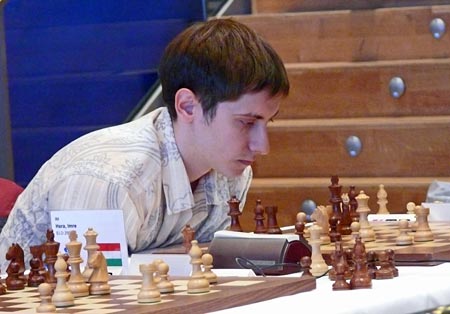| Latest | Greatest | Lobby | Journals | Search | Options | Help | Login |
|
|
|
This topic is archived. |
| Home » Discuss » Topic Forums » Sports |
|
| Jack Rabbit
|
Sun Apr-08-07 04:22 PM Original message |
| The Jack Rabbit Chess Report for April 8 |
|
Edited on Sun Apr-08-07 04:34 PM by Jack Rabbit
The Jack Rabbit Chess Report for the week ending April 8  from Chancellor.net Contents Post 1: News for the week Post 2: Diagrams and other features Post 3: Games from Current and Recent Events Post 4: Bonus Game: Teimour Radjabov - Vishy Anand, FIDE Grand Prix, Round 4, Dubai 2002 |
| Printer Friendly | Permalink | | Top |
| Jack Rabbit
|
Sun Apr-08-07 04:22 PM Response to Original message |
| 1. News for the week ending April 8 |
|
European Individual Championships in Dresden
 Five-Way tie for first in Open Division Five players are tied for first place after six rounds in the Open Division of the European Individual Championships in Dresden. Andrei Volokitin of Ukraine began the day in sole possession of first place, but drew his game with Hungary's Zoltan Almasi. Almasi and 20 other players began the day tied for second with 4 points each; the four of those who won their games today are now tied with Volokitin for first place. In addition to Volokitin at 5 points, the top board winners today now also at 5 points are Vlad Tkachief of France, Vlad-Cristian Jianu of Romania, Alexander Moiseenko of Ukraine and Sergey Volkov of Russia. Russian grandmaster Dmitry Jakovenko, the top ranked player in the event, was an early leader, but is now among those tied for sixth with 4½ points. There are 403 participants in the open competition. Tatiana Kosintseva perfect after six rounds in ladies' competition Tatiana Kosintseva, the younger half of the chess-playing Kosintseva sisters from the White Sea port of Arkhangelsk in Russia, is leading the ladies' completion in Dresden with a perfect score after six rounds. Today, Ms. Kosintseva won her game from Poland's Iweta Rajlich, a member of the team that created the Rybka chess engine. Yesterday, Ms. Kosintseva defeated Zeinab Mamedjarova of Azerbaijan, who was also perfect after four rounds, in a wild, anti-theoretical game marred by inaccurate play be both sides in mutual severe time trouble. Ms. Kosintseva delivered checkmate with less than a minute remaining on her clock and still five moves away from the time control. Ms. Kosintseva's sister, Nadezhda, is also in Dresden. she is tied for second with 5 points with Eva Moser of Austria, Hoang Thanh Trang of Hungary and the defending tournament champion, Ekaterina Atalik of Turkey. Ms. Mamedjarova is also a part of a chess playing siblings act; her younger sister, Turkan, is also competing in Dresden and her older brother is Shakhiyar Mamedyarov, the world sixth-ranked grandmaster. One hundred forty-nine ladies are competing in Dresden. Both the open and ladies' events are eleven rounds and will be completed Saturday. Shabalov, Ehlvest lead Foxwoods Open  The Foxwoods Open, one of the great annual chess events in the United States, is underway in Mashantucket, Connecticut. After seven rounds, grandmasters Alex Shabalov and Jaan Ehlvest lead with 6 points apiece. International master Jesse Kraai joins grandmasters Ildar Ibragimov. Yuri Shulman and the highest ranked US grandmaster, Gata Kamsky, in a tie for third with 5½ points each. Shabalov and Ehlvest met in round 4 of the nine-round Swiss system event and played to a draw. Neither has lost a game thus far and both have won 5. The Foxwoods has a punishing schedule of two games a day. The event concludes this evening. |
| Printer Friendly | Permalink | | Top |
| Jack Rabbit
|
Mon Apr-09-07 03:42 PM Response to Reply #1 |
| 10. Update: Kamsky wins Foxwoods . . . Kosintseva still perfect after 7 |
|
Gata Kamsky wins Foxwoods Open
Gata Kamsky, America's leading grandmaster and the 19th ranked grandmaster in the world, came from behind in the final two rounds to win the Foxwoods Open in Mashantucket, Connecticut. Kamsky defeated Yuri Shulman in the eighth round Sunday morning and drew with Ildar Ibramigov in the final round to finish with 7 points. That tied him with Zviad Izoria. A single blitz game was played to determine the tournament champion. Kamsky, playing Black, defeated Izoria in 29 moves. The leaders after Saturday's rounds, Alex Shabalov and Jaan Ehlvest, both faltered on Sunday. Ehlvest lost in round eight to Ibragimov and drew his final game to finish a half-point behind the leaders. Shabalov suffered two losses on Sunday to finish with 6 points out of nine. Tanya Kosintseva still perfect in Dresden Tatiana Kostintseva of Russia won her seventh game in as many rounds in the ladies' competition at the European Individual Championships in Dresden earlier today (Monday) to open up a point and a half lead over the rest of the field. Ms. Kosintseva, playing Black, defeated Austria's Eva Moser today. Among those tied for second with 5½ point is Tatiana's older sister, Nadezhda.  The Kosintseva sisters in Dresden Tatiana (left) and Nadezhda Tomorrow, Tatiana will play White against the reigning Russian ladies' champion, Ekaterina Korbut. In the open competition, Andrei Volokitin of Ukraine, playing White, defeated Russia's Sergey Volkov in 28 moves today to regain sole possession of first place. |
| Printer Friendly | Permalink | | Top |
| Jack Rabbit
|
Sun Apr-08-07 04:24 PM Response to Original message |
| 2. Diagrams and other features of the JR Chess Report |
|
!""""""""# $tMvWlVmT% $OoOoOoOo% $ + + + +% $+ + + + % $ + + + +% $+ + + + % $pPpPpPpP% $RnBqKbNr% /(((((((() White to move This position is a theoretical draw Does this picture make sense to you? If not, or if it looks like a bunch of Wingdings, please click here. Diagrams used in the Jack Rabbit Chess Report are made with Chess Merida, a true type font that is available as freeware at the above link. Also, the JR chess report makes the main variation in annotations more distinct and readable by putting it in red. A secondary variation, is in blue and other colors are used if needed. |
| Printer Friendly | Permalink | | Top |
| Jack Rabbit
|
Sun Apr-08-07 04:25 PM Response to Original message |
| 3. Games from current and recent events |
|
Edited on Sun Apr-08-07 04:36 PM by Jack Rabbit
Chess Games Analysis by JR and Fritz Ketevan Arakhamia-Grant - Elena Levushkina, European Individual Championships, Round 2, Dresden Dmitry Jakovenko - Piotr Borbas, European Individual Championships, Round 2, Dresden Daniel Rensch - Alex Shabalov, Foxwoods Open, Round 3, Mashantucket, Connecticut Zeinab Mamedjarova - Anna Muzychuk, European Individual Championships, Round 4, Dresden Zeinab Mamedjarova - Tatiana Kosintseva, European Individual Championships, Round 5, Dresden |
| Printer Friendly | Permalink | | Top |
| Jack Rabbit
|
Sun Apr-08-07 04:27 PM Response to Reply #3 |
| 5. Arakhamia-Grant - Levushkina, Round 2, Dresden |
|
Ketevan Arakhamia-Grant still plays under the flag of her native Georgia, although she has been a resident of Edinbourgh for many years with her husband, former Scottish champion Jonathan Grant, and their children. Ms. Arakhamia-Grant is also a former Scottish champion (not the women's champion, the overall champion) and is the reigning vice champion of the British Isles (not the women's vice champion, the overall vice champion; she is also the reigning women's champion).
 Ketevan Arakhamia-Grant Ketevan Arakhamia-Grant vs. Elena Levushkina European Individual Championships, Round 2 Dresden April 2007 Epine Dorsal: Horseman Defense (Petroff Defense) 1. e4 e5 2. Nf3 Nf6 3. Nxe5 d6 4. Nf3 Nxe4 5. Nc3
Black: Elena Levushkina !""""""""# $t+ W Tl+% $Oo+ V Oo% $ +oO + +% $+ + O + % $ + + + +% $+ PbQ + % $pPp+ PpP% $+k+r+ +r% /(((((((() White: Ketevan Arakhamia-Grant Position after 15. -- c7c6 16. h4!?
Black: Elena Levushkina !""""""""# $t+ + +l+% $Oo+ + Oo% $ +oO V T% $+ + W +p% $ + + Qp+% $+ Pb+ + % $pPp+ + +% $+k+r+ +r% /(((((((() White: Ketevan Arakhamia-Grant Position after 21. -- Qe8e5 22. Qb4!
|
| Printer Friendly | Permalink | | Top |
| Jack Rabbit
|
Sun Apr-08-07 04:28 PM Response to Reply #3 |
| 6. Jakovenko - Borbas, Round 2, Dresden |
|
Edited on Sun Apr-08-07 04:48 PM by Jack Rabbit
This game was played in the same round as the previous one and featured a similar kingside attack.
 Dmitry Jakovenko Dmitry Jakovenko vs. Piotr Bobras European Individual Championships, Round 2 Dresden, April 2007 Spanish Grand Royal Game: Worrell Opening (Gothic Defense) 1. e4 e5 2. Nf3 Nc6 3. Bb5 a6 4. Ba4 Nf6 5. Qe2
Black: Piotr Bobras !""""""""# $t+ WmTl+% $+ O MoOo% $o+ + + +% $+o+oP +v% $ V P + +% $+bN Bn+p% $pP +qPp+% $R + +rK % /(((((((() White: Dmitry Jakovenko Position after 14. -- Bf4h5 15. g4!
Black: Piotr Bobras !""""""""# $t+ W Tl+% $+ + M O % $o+o+ +p+% $+o+ + + % $ V Po+ N% $+v+ B +p% $pP +q+ +% $R + +rK % /(((((((() White: Dmitry Jakovenko Position after 23. -- Bf7b3:B 24. Qh5!! 1-0
|
| Printer Friendly | Permalink | | Top |
| Jack Rabbit
|
Sun Apr-08-07 04:29 PM Response to Reply #3 |
| 7. Rensch - Shabalov, Foxwoods Open, Round 3, Mashantucket |
|
Alex Shabalov is my favorite American chess master.
He was born in Soviet Latvia and was a protoge of the late, great former world champion, Mikhail Tal, whose style Mr. Shabalov honors with his play.  Alex Shabalov Daniel Rensch vs. Alex Shabalov Foxwoods Open, Round 3 Mashantucket, Connecticut, April 2007 Open Sicilian Game: Sveshnikov Defense 1. e4 c5 2. Nf3 Nc6 3. d4 cxd4 4. Nxd4 Nf6 5. Nc3 e5 6. Ndb5 d6 7. Bg5 a6 8. Na3 b5 9. Bxf6 gxf6 10. Nd5 f5 11. Bd3
Black: Alex Shabalov !""""""""# $t+ +t+l+% $+r+ MoVo% $ +nO + +% $O +p+o+q% $ + +oP +% $+ P + + % $w+ +b+pP% $+ + +r+k% /(((((((() White: Daniel Rensch Position after 23. Rb1b7 23. -- Kf8!
Black: Alex Shabalov !""""""""# $t+ +t+l+% $+ +pRoVo% $ + + + +% $+ P M + % $ + +q+ +% $+ + + + % $o+ Wb+pP% $+ + +r+k% /(((((((() White: Daniel Rensch Position after 32. d6d7 32. -- Qxd7!!
|
| Printer Friendly | Permalink | | Top |
| Jack Rabbit
|
Sun Apr-08-07 04:31 PM Response to Reply #3 |
| 8. Z. Mamedjarova - A. Muzychuk, Round 4, Dresden |
 Zeinab Mamedjarova Zeinab Mamedjarova vs. Anna Muzychuk European Individual Championships, Round 4 Dresden, April 2007 Indian Game: Benko-Volga Gambit 1. d4 Nf6 2. c4 c5 3. d5 b5 4. cxb5 a6 5. b6 e6
Black: Anna Muzychuk !""""""""# $ +vW Tl+% $+ + +oOo% $o+ O V +% $+ + + + % $ Mb+p+ +% $+ B Qn+ % $p+t+ PpP% $R + +rK % /(((((((() White: Zeinab Mamedjarova Position after 17. -- Rb2c2 18. e5!
|
| Printer Friendly | Permalink | | Top |
| Jack Rabbit
|
Sun Apr-08-07 04:32 PM Response to Reply #3 |
| 9. Z. Mamedjarova - T. Kosintseva, Round 5, Dresden |
|
This was played in Round 5 in Dresden yesterday (Saturday). Both ladies went into the game with perfect scores through four rounds.
This isn't the best game presented this week, but it may be the most exciting.  Tatiana Kosintseva Zeinab Mamedjarova vs. Tatiana Kosintseva European Individual Championships, Round 5 Dresden, April 2007 Queen's Gambit: Ragozin Defense (Harrwitz Opening) 1. d4 Nf6 2. c4 e6 3. Nf3 d5 4. Nc3 Bb4 5. Bf4!?
Black: Tatiana Kosintseva !""""""""# $t+v+ Tl+% $Oo+ +oOo% $ +m+o+ +% $W Po+ + % $ Vp+mB +% $PqN Pn+ % $ P + PpP% $+ R Kb+r% /(((((((() White: Zeinab Mamedjarova Position after 10. Ra1c1 10. -- Bxc3+!
Black: Tatiana Kosintseva !""""""""# $ +t+t+l+% $O + +oOo% $ +v+ + +% $+o+ + W % $mV P + +% $P P +q+ % $ +k+ PpP% $+ R +b+r% /(((((((() White: Zeinab Mamedjarova Position after 23. -- Bc6 24. Qg3!
Black: Tatiana Kosintseva !""""""""# $ +t+t+l+% $+ + +oOo% $ + B + +% $Ob+v+ + % $m+ P + +% $P P +pQ % $ + K +pP% $+ R + +w% /(((((((() White: Zeinab Mamedjarova Position after 32. Rc2c1 32. -- Qxc1+!!
|
| Printer Friendly | Permalink | | Top |
| Jack Rabbit
|
Sun Apr-08-07 04:26 PM Response to Original message |
| 4. Bonus Game: Radjabov-Anand, Dubai 2002 |
|
This week, the JRCR celebrates the new number one ranked grandmaster in the world, Vishy Anand, with one of his finest games.
 Vishy Anand Teimour Radjabov vs. Vishy Anand FIDE Grand Prix, Round 4 Dubai, April 2002 East India Game: Queen's Indian Defense (Petrosian Opening) 1. d4 Nf6 2. c4 e6 3. Nf3 b6 4. a3
Black: Vishy Anand !""""""""# $ + W Tl+% $O Tm+oOo% $ O Vo+ +% $+ + + + % $ + P + +% $P Pb+q+ % $ B + PpP% $+ +r+rK % /(((((((() White: Teimour Radjabov Position after 18. Ba6d3 18. -- b5?!
Black: Vishy Anand !""""""""# $ W T +l+% $+ T VoO % $o+ +oM O% $+ + + + % $o+pP + +% $+ +b+q+r% $ + + PpP% $Br+ + K % /(((((((() White: Teimour Radjabov Position after 26. Rd1b1 26. -- Rxc4!!
|
| Printer Friendly | Permalink | | Top |
| DU
AdBot (1000+ posts) |
Sun Nov 03rd 2024, 08:02 AM Response to Original message |
| Advertisements [?] |
| Top |
| Home » Discuss » Topic Forums » Sports |
|
Powered by DCForum+ Version 1.1 Copyright 1997-2002 DCScripts.com
Software has been extensively modified by the DU administrators
Important Notices: By participating on this discussion board, visitors agree to abide by the rules outlined on our Rules page. Messages posted on the Democratic Underground Discussion Forums are the opinions of the individuals who post them, and do not necessarily represent the opinions of Democratic Underground, LLC.
Home | Discussion Forums | Journals | Store | Donate
About DU | Contact Us | Privacy Policy
Got a message for Democratic Underground? Click here to send us a message.
© 2001 - 2011 Democratic Underground, LLC